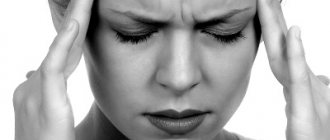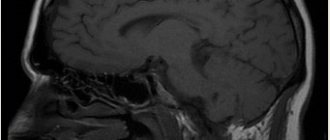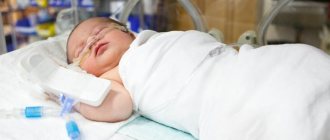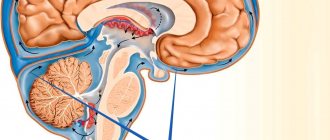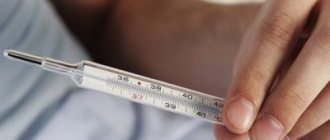Consultation with a neurologist – RUB 1,750.
- What is encephalopathy?
- Types of acquired encephalopathy
- Symptoms of the disease
- Diagnostics
- Treatment of encephalopathy
- Popular questions
Encephalopathy
is a general term used to describe non-inflammatory diseases of the brain.
Characterized by a decrease in the volume of nervous tissue and impaired brain function. Encephalopathy of the brain can be congenital
or
acquired
. Congenital encephalopathy occurs due to genetic disorders or abnormal development of the brain during fetal development, or damage to the brain during childbirth.
Acquired encephalopathy is divided into several types.
Types of acquired encephalopathy
Depending on the cause of the disease, the following types of acquired encephalopathy are distinguished:
- Post-traumatic encephalopathy
- develops as a result of traumatic brain injury. It is often detected in athletes. It happens that signs of the disease appear long after the head injury. - Toxic encephalopathy
is caused by long-term negative effects on the brain of toxic substances, for example, alcohol, certain medications, heavy metals, and poisons. - Discirculatory encephalopathy
- occurs due to insufficient blood supply to the brain. - Residual encephalopathy
occurs due to the death of cells of the central nervous system. - Hepatic and uremic encephalopathy
- caused by severe diseases of the liver and kidneys. - Pancreatic encephalopathy
- occurs with diseases of the pancreas. - Hypoglycemic and hyperglycemic encephalopathy
- occurs in diabetes mellitus. - Radiation encephalopathy
– occurs due to radiation damage. - Vascular encephalopathies
- occur with chronic disruption of the blood supply to the brain. They develop as a result of atherosclerosis of cerebral vessels, hypertension, etc.
Non-drug treatment
A necessary condition for the success of treatment is the inclusion of non-drug methods, which include:
- classes with a speech therapist;
- massage;
- exercise therapy;
- sessions with a psychologist;
- short-term sessions of individual psychotherapy for 1 hour 2 times a week after 3, 6, 12 months;
- dolphin therapy;
- occupational therapy;
- hippotherapy;
- acupuncture;
- magnetotherapy.
For treatment to be effective, a trusting relationship, mutual understanding and proper contact should be established between the child and the specialist. You can use family and behavioral psychotherapy.
The following exercises and tasks are used to develop speech:
- Teach your child to talk about the image in the picture. There is no need to change pictures often. It is advisable to gradually increase your vocabulary by describing the same picture.
- It is emotional to tell a child a story, making him want to imitate you.
- Read a short, interesting story and ask to retell it.
- Learn poems, nursery rhymes, and songs together.
- Communicate with the baby as much as possible, while trying not to understand his gestures, but insist on pronouncing sounds, syllables and words.
- Show the child the images, ask them to arrange them sequentially and make up a story.
- Constantly enrich your child’s vocabulary.
- Learn to speak in a monologue, and in the future - maintain a dialogue.
- Try together to describe, compare, teach to generalize events and natural phenomena.
One of the most basic conditions for achieving success is that a child should be interested in playing and learning. During joint classes, the atmosphere should be friendly.
Children with mental retardation have difficulty maintaining attention, quickly lose interest in a task, get distracted, and often cannot complete the game. This affects speech development, so you need to show tact and patience. The duration of classes should increase gradually.
Several exercises for home exercises to correct mental retardation:
- Guess who. Hide toys or pictures of animals and invite them to look for them, while imitating their voices.
- Guess the toy. Scatter toys around the room, offer to find one of them, naming only its signs.
- Parts of the whole. Show a picture or toy, naming parts of the object (nose, eyes, ears, head, neck, arms, legs, torso, tail), ask to repeat after the adult.
- Which? Consider five familiar toys or household items. Guess and take them out of a box or bag, then invite the baby to describe them, naming the color, shape, surface, taste, etc.
- Call me kindly. Show a picture of a large object and offer to name the same small object affectionately.
- What is missing. Show pictures that show objects with missing parts (a ball without a thread, a flower without a stem, a flag without a stick).
- What didn't happen? Show first three toys, then more, invite the baby to close his eyes, remove one and then name the one that disappeared, remember where it was, return it to its place, then switch roles.
Diagnosis of encephalography
Diagnosis of the disease is carried out using a number of methods:
- Rheoencephalography (REG)
is a non-invasive examination method that allows you to obtain information about the condition of the walls of blood vessels in the brain. - Doppler ultrasound (USD)
is a safe and highly informative method for diagnosing vascular disorders that lead to the development of encephalopathy. - MRI
- MRI of the vessels of the brain, head and neck, pituitary gland, and eyeball is performed.
For some types of encephalopathies (for example, dyscirculatory encephalopathy), the following are used as diagnostics: Source: Kadykov A.S. Dyscirculatory encephalopathy: algorithm for diagnosis and treatment in patients with arterial hypertension / A.S. Kadykov, N.V. Shakhparonova // Neurology, neuropsychiatry, psychosomatics. - 2010. - pp. 12-17.
- neuropsychological research with special attention to the state of memory, attention and intelligence;
- ECG and dynamic blood pressure measurement, if necessary, echocardiography, Holter monitoring, 24-hour blood pressure monitoring;
- study of lipid and carbohydrate metabolism.
Danilova Olga Andreevna
neurologist
Encephalopathy is a group of diseases, the main manifestation of which is the gradual degeneration of brain tissue. To treat the disease, it is important to eliminate the main factor that is gradually destroying the brain. This may be insufficiency of liver or kidney function, atherosclerosis, previous traumatic brain injury, diabetes mellitus and many other reasons. At SM-Clinic we carry out a full diagnosis to determine the cause of encephalopathy, and only after that we begin treatment.
Symptoms and signs of the disease
In residual encephalopathy, the syndromes depend on the damaging factor.
With congenital pathology, the child often cries, becomes restless, has inadequate reactions to sound or light, throws his head back and bulges his eyes. In half of the cases, signs of the disease do not appear after birth. In the first months of a child’s life, encephalopathy often provokes the development of hydrocephalus, an increase in the amount of cerebrospinal fluid in the brain, strong intracranial pressure, and developmental delays.
Symptoms of the disease may appear over time; they may be insignificant, but as the child grows, they become more pronounced. Relapses of the pathology usually occur after inflammatory and infectious diseases, head injury, and hypertension. A person experiences nausea, vomiting, memory and motor coordination disorders. Sometimes the disease manifests itself without the influence of provoking factors.
Characteristic signs of the disease are:
- frequent headaches;
- paresis and loss of consciousness;
- VSD, mental disorders;
- impaired coordination of movements;
- memory and emotional disorders;
- disorder of periods of sleep and wakefulness.
In severe cases, the disease provokes the development of paralysis, Parkinson's syndrome, seizures, epilepsy, speech disorders, and coma.
Residual encephalopathy is a persistent, slowly developing neurological syndrome that is a complication of diseases and negative effects on the brain. Often in medicine, this pathology is diagnosed as a mental illness and symptomatic treatment is provided.
Treatment of encephalopathy
Treatment methods for encephalopathy directly depend on the disease that caused the brain damage.
The most common treatment methods are:
Drug treatment
— a wide range of different groups of drugs are used, which are selected depending on the cause of the disease, possible concomitant diseases, and the individual characteristics of the patient’s body. Drugs that optimize cerebral circulation, neuroprotectors, vasodilators, diuretics, nootropics, amino acids and other drugs are prescribed.
Physiotherapeutic treatment
— for non-drug treatment of encephalopathy
magnetic therapy
, electromagnetic stimulation,
electrophoresis
,
ultraviolet irradiation of blood , ozone therapy
,
acupuncture
, and plasmapheresis are used.
Surgery
— most often, operations are performed on blood vessels necessary to normalize blood flow in the brain. Surgical treatment is used for brain tumors, traumatic brain injury, congenital anomalies of cerebral vessels
Lifestyle correction
— in order to increase the effectiveness of treatment, it is recommended to lose excess weight, eliminate saturated fats, salt, alcohol from the diet, move more, stop smoking and taking drugs.
If symptoms of encephalopathy occur, you should seek medical help as soon as possible. If you delay the start of treatment, there is a risk of depression of brain function and even disability.
Timely treatment, in turn, can not only slow down the development of the pathology, but also completely get rid of the negative consequences of the disease.
| Name of service (price list incomplete) | Price, rub.) | In installments* |
| Electrophoresis (1 field) | from 700 | — |
| UHF therapy (1 field) | from 700 | — |
| Magnetotherapy category I difficulty | from 550 | — |
| MRI of the brain | 4 200 | — |
* You can read more about the conditions here - Treatment on credit or in installments.
Types of pathology
In medicine, there are several types of pathology
A congenital pathology that begins to form during the period from the twenty-eighth week of a woman’s pregnancy to the seventh day after the birth of the child (perinatal period). In this case, residual encephalopathy (ICD code 10 is indicated above) develops as a result of the influence of negative factors during a woman’s labor or as congenital genetic abnormalities in the development of the brain. The main feature of this type of disease is its occurrence due to the development of abnormal processes during pregnancy or childbirth of a woman.
Acquired pathology develops during human life. It has several subspecies:
- metabolic residual encephalopathy (ICD 10 - G93.4) is formed as a result of diseases of the internal organs, when toxins begin to penetrate the blood and spread to the brain;
- vascular develops due to chronic cerebrovascular accident;
- discirculatory is formed as a result of cerebrovascular disorders;
- toxic, which occurs when the human body is exposed to toxins;
- post-traumatic residual encephalopathy (ICD code - T90.5) develops as a result of TBI;
- radiation, which is formed under the influence of ionizing radiation.
Residual encephalopathy: ICD 10 code, syndromes, treatment
Cerebral ischemia: why it develops and why the pathology is dangerous
Residual encephalopathy is a common diagnosis in neurological practice. Usually it means suffering of the brain (encephalon - brain, pathia - suffering), under the influence of some transferred factor. After all, the term residual means persisting.
There may be many reasons for the development of residual encephalopathy:
- Perinatal (most often hypoxic) damage. This includes birth trauma, hypoxia during childbirth and other reasons. This type of residual encephalopathy is typical for children, although sometimes it is permissible to use the term cerebral palsy (cerebral palsy) if the signs of damage affect the motor sphere and are expressed quite roughly.
- Traumatic brain damage. Although sometimes it is acceptable to use the term post-traumatic encephalopathy.
- Dysontogenetic conditions (Arnold-Chiari malformation, for example, congenital hydrocephalus, etc.). By and large, they affect any features of abnormal brain development.
- Past neuroinfections (tick-borne encephalitis, meningoencephalitis of various etiologies, etc.).
- Previous neurosurgical interventions, including those for brain tumors, with the appearance/maintenance of a neurological defect after them.
- Other traumatic factors suffered that left neurological symptoms, if there is a full correlation with the traumatic event.
Residual encephalopathy code according to ICD 10
The code for residual encephalopathy according to ICD 10 coding is a rather controversial issue. Personally, in my practice I use the code G93.4 - encephalopathy unspecified, and, at least for now, this code does not cause any complaints from insurance companies. And in general, soon there will be an ICD-11 cipher system.
Someone, as far as I know, uses the code G93.8 - other specified brain damage, but it is more logical to include radiation damage in this terminology. For traumatic effects, the code T90.5 or T90 can be used.
8 (consequence of intracranial and consequence of other specified head injury).
When making a diagnosis, it is also important to indicate in parentheses the damaging agent or influence (a consequence of a neuroinfection, a consequence of a head injury from such and such a year, etc.), indicate the syndromes (vestibular-coordinating for dizziness, cephalgic for headaches, etc.) , it will also be important to indicate the severity of the syndromes, the stage of compensation of the process
Symptoms and diagnosis of residual encephalopathy
The symptoms of residual encephalopathy can be very diverse.
With residual encephalopathy, syndromes such as cephalgic (headaches), vestibulo-coordinator (various types of dizziness, as well as impaired coordination of movements, including instability in the Romberg position), asthenic (weakness, fatigue), neurotic (mood lability) may occur. , cognitive impairment (decreased concentration, memory, etc.), dyssomnia (sleep disorders) and many others. Dizziness occurs in more than 50% of cases.
There are no clear diagnostic criteria for establishing a diagnosis of residual encephalopathy.
Typically, the diagnosis is made on the basis of complaints (diagnosed syndromic), anamnesis (the presence of an established damaging effect on the brain), as well as on the basis of a neurological examination with the identification of a neurological deficit.
Also important for making a diagnosis are neuroimaging examination techniques (MRI of the brain), as well as functional studies such as EEG, REG.
Treatment of residual encephalopathy
There is no consensus or standard of care for the treatment of residual encephalopathy. Various groups of neuroprotective drugs are used (Cerebrolysin, Actovegin, Ceraxon, Gliatilin, Glycine, Gromecin, etc.
), antioxidants (Mexidol in injection and tablet forms, Thioctic acid, etc.), in some cases they are used in vasoactive therapy (Cavinton in the form of injections, tablets, including for resorption in case of swallowing disorders).
For dizziness, betahistine preparations (Betaserc, Vestibo, Tagista and others) are used.
Important measures will include physical therapy (including vestibular gymnastics for vestibular dysfunction and dizziness), massage, and physical therapy techniques.
It is important to know that the prognosis for residual encephalopathy is usually. positive and treatment can have an effect
Perinatal form
Dyscirculatory encephalopathy of the brain - causes, symptoms, diagnosis and treatment standards
Perinatal encephalopathy is a common etiological form of the pathological process, indicating intrauterine cerebral damage to the fetal nervous system for a number of reasons. The concept was introduced back in 1976. It develops from the third trimester of pregnancy to the 7th–10th day of life. The perinatal form is diagnosed in the first months of the baby’s life. The following types are distinguished:
- bilirubin - the main reason is the poisoning of nerve cells with bilirubin due to stagnation of bile;
- residual encephalopathy, when the true cause is difficult to find out, and the first symptoms appear much later, as nerve cells die;
- post-hypoxic ischemic – occurs due to blockage of blood vessels and hypoxia;
- epileptic – occurs with high convulsive activity;
- transient – episodic cerebrovascular accident;
- unspecified form - the causes of the lesion remain unclear, sometimes it is a number of different negative factors.
When pathology occurs in newborns, the risk of developing convulsive syndrome at a later age increases. The residual form of the disease requires special attention due to its hidden course and onset.
